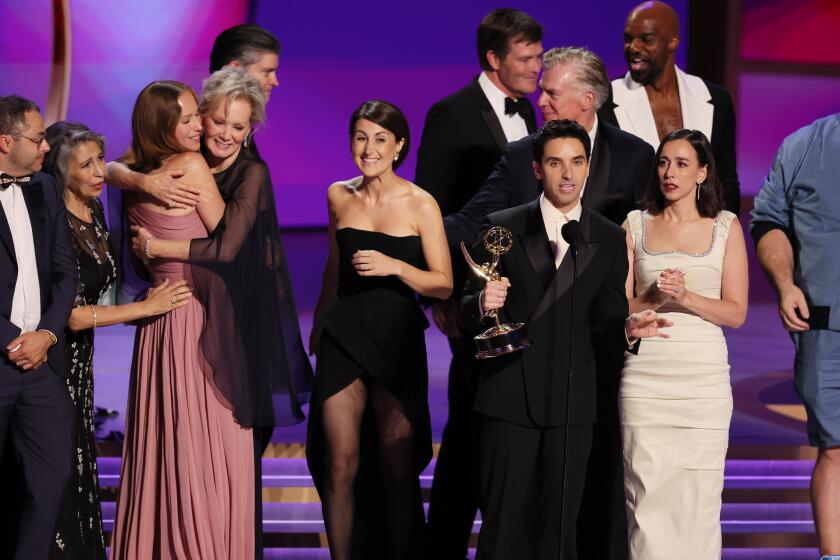Emmy Countdown : Emmys Set Designed for More Than Millennium : Television: Veteran Roy Christopher wants the futuristic staging and sophisticated lighting at the Shrine to focus on the presenters and winners.
- Share via
It’s nine days before the 51st annual Emmy Awards and the stage of the Shrine Auditorium is a hubbub of activity.
There’s a cacophony of hammers and drills and shouts of workmen who are busy constructing the sleek white and gray set designed by Roy Christopher.
But the veteran production designer seems as cool as a cucumber sitting where the audience will sit Sunday night, watching his latest creation slowly take shape.
And for good reason. He’s been designing awards shows and specials for more than 20 years. Nominated for 30 Emmys and winner of six, Christopher is the only production designer to do the Oscars, Tonys and Emmys in one year. He’s designed 12 Emmy Awards shows, six Tonys, six TV “Academy Hall of Fame” specials, and most recently, “An American Celebration at Ford’s Theatre.”
His design for this year’s Emmys, he says, is futuristic--a celebration of the new millennium. “It’s a kind of very forward-looking show,” Christopher says.
The most eye-catching aspect of the set is a gigantic, revolving Emmy Award located center stage and enclosed in a glass cone. “We will fill that with billowing smoke and colored lights,” Christopher says.
The orchestra will be stage right. Emmy orbs will also adorn the set. “It’s a little bolder than usual,” says Christopher, who also designs the popular sitcoms “Frasier” and “Becker” and has designed for such classic comedies as “Chico and the Man,” “Welcome Back Kotter” and “Murphy Brown.”
“This basic set costs so much we didn’t have a lot of money for other sets,” Christopher explains. “We are making this work for everything with small changes. It will work verywell.”
This is Christopher’s eighth Emmy Awards and his second for producer Don Mischer, who gave him free rein in creating the set.
“I came in with this and he was very enthusiastic,” Christopher recalls. “Most of us who do these kind of things and work with each other for a long time, you learn to work in a shorthand. You know each other’s strengths and weaknesses.”
Christopher enjoys designing for the Shrine stage, which has a 100-foot proscenium, 40 feet longer than the Emmys’ former home, the Pasadena Civic Auditorium.
“I think this is the sixth show I have done at the Shrine,” he says. “At first I didn’t like it so much. I thought it was too big. But now I have learned to enclose it and focus the attention to the center of the stage and make it work for the show.”
Besides, he says, audiences today are sophisticated enough that they don’t need that constant bombardment of set changes. “They are really interested in the people. If we design a beautiful space, who cares if you are seeing it all night. You concentrate on the people. You are interested in the story which is being told and the winners. It is not about changing sets constantly.”
Still, Christopher says, you want a sense of the event. “On the other hand, you don’t want it to seem like you are removed from it. Sometimes the sets, when [the TV cameras] take the wide shot, you don’t know what in the world you are looking at.”
The set has to work for the balcony seats as well as those front-row center. “It has to be bold to kick up in the balcony for them,” he says. “I think most shows are pretty much getting to be much more elegant and visual.”
The set will only appear in its white and gray form once during the ceremony. “With automated lights we change color and change texture,” Christopher says. “We change patterns and the whole thing will change its look throughout the show. What I am giving them here is a very neutral palette that we can put light upon. I told the lighting guys I want it to look this way at least once.”
Christopher envisions emerald green, rubies and jewel tones for the lighting. “Not the primary colors, but secondary, rich glowing colors is what I see. The lighting designer, Bob Dickinson, and I love blue, so you’ll see a lot of blue.”
Lighting has become much more sophisticated over the past two decades. “I remember the day we would have to hang all of these instruments. They weren’t automated and they all had to be focused by hand. They would have to put up hundreds of lights. Now they can use fewer lights, but they all have the capability of moving and changing focus. I’m so much into the lighting aspect, when I design something, I bring in Bob right away and he looks at the piece.”
Christopher says that he gave up years ago trying to get presenters to wear something other than black. “We try,” he says. “We say don’t wear all black. It’s chic and it’s beautiful, but if you could, wear color. It would be beautiful on a set like this to have someone come out in a red dress. I did notice last year on the Emmys there was a lot more color, less black. It was nice to have that mix.”
More to Read
The complete guide to home viewing
Get Screen Gab for everything about the TV shows and streaming movies everyone’s talking about.
You may occasionally receive promotional content from the Los Angeles Times.







